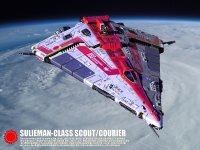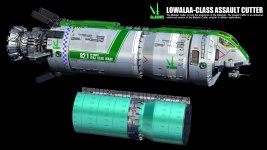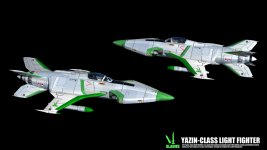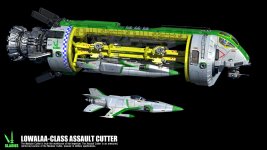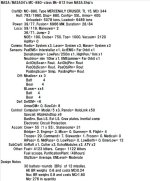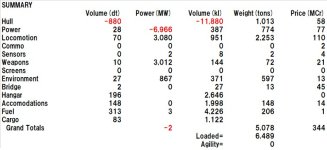You are using an out of date browser. It may not display this or other websites correctly.
You should upgrade or use an alternative browser.
You should upgrade or use an alternative browser.
Starships
- Thread starter magmagmag
- Start date
You noticed and solved my code.KFC. Boy, that's a lot of chicken. Nice to see some corps have long legs into the future.
infojunky
SOC-14 1K
Oh, Man, the Smell.... Years ago I had a job locking up buildings and answering alarms, one of the plants and associated warehouses made all the seasonings for all of KFC's menu. They both were very Odiferous one the days when they were filling those orders... Yes, I have seen containers of those products.KFC. Boy, that's a lot of chicken. Nice to see some corps have long legs into the future.
Spinward Flow
SOC-14 5K
Looking at this design, I'm concerned about the hull skin fluid flow dynamics to be used for those fuel scoops. I think the main thing that makes me "???" is how the fuel scoops run the entire circumference except for the spine. This only makes sense if the hull pitch angle during flight is at 0º to the direction of movement (so no slight pitch up to fly level, like with an aircraft). Additionally, the fuel scoops towards the dorsal spine are going to be quite useless during ocean refueling in a water landing.
Consequently, my natural aerospace design instinct is in favor of something more akin to a ventral only intake, which then uses the hypersonic orbital speed of a skimming run through the upper layers of a gas giant to ram compress atmospheric H2 into the fuel scoop on the underside while the entire Modular Cutter maintains a slight pitch up attitude in forward flight to assist the ram scooping without creating too much drag. Additionally, when making a water landing, you want the (water) fuel scoop to be ventral so as to keep the entire craft interior "right side up" rather than rolling over to the side or onto the dorsal spine. That way, you basically "dunk" the fuel scoops into the water while floating on the ocean surface, open the valves and let the water flood inside the fuel tank from underneath the Modular Cutter.
Fun side note, the buoyancy of the Modular Cutter will change as it gets filled up with (water) fuel, so for a water landing the craft will start out riding high on the water and then sink into the water as the fuel module gets filled up with water. Ideally, when fully loaded with water from an ocean, the waterline along the hull (plus waves) should not quite reach the cockpit windows, so you want to keep the forward windows above the waterline at all times (although waves may break and splash over the windows). When empty and beginning an ocean scoop, the craft would ride higher in the water with the waterline lower down towards the underside of the hull ... much like you see with giant cargo and tanker ships when they are empty (riding high) and full (riding low) due to buoyancy keeping them afloat under different loads. Note that this probably means that when the fuel tank is empty the side hatch is probably just clearing the waterline as the craft rests in the water, but when the fuel tank is loaded with water the side hatch is almost certainly partially submerged into the water line (so don't open it under those conditions).
The craft would use gravitics to lift away from the surface of the water and gain altitude before engaging the HEPlaR drive seen at the aft end (which probably would not "work right" if partially submerged in water).
Kind of worried about the 90º angle under the cockpit, since that would tend to act like an air dam during hypervelocity maneuvers. I'm thinking it would create enough drag force at high velocity drag to destabilize flight due to drag differential between the upper and lower sections up front, creating a pitching moment that could cause the Modular Cutter to tumble out of control even at high subsonic speeds. Might want to reshape this into more of an angled hull surface which can open up to reveal the turret installation.
Your work is really good, as a few others have noted.Fuel Skimmer
Intended to dive into gas giants and skim their hydrogen gas for fuel. It may be used to dip water from oceans as well. Carries 28 tons of fuel. MCr 1.0.
I have a silly question about the Modular Cutter, which version are using for the base dimensions? CT etc. or GURPS?
Thanks comment.
Looking at this design, I'm concerned about the hull skin fluid flow dynamics to be used for those fuel scoops. I think the main thing that makes me "???" is how the fuel scoops run the entire circumference except for the spine. This only makes sense if the hull pitch angle during flight is at 0º to the direction of movement (so no slight pitch up to fly level, like with an aircraft). Additionally, the fuel scoops towards the dorsal spine are going to be quite useless during ocean refueling in a water landing.
Consequently, my natural aerospace design instinct is in favor of something more akin to a ventral only intake, which then uses the hypersonic orbital speed of a skimming run through the upper layers of a gas giant to ram compress atmospheric H2 into the fuel scoop on the underside while the entire Modular Cutter maintains a slight pitch up attitude in forward flight to assist the ram scooping without creating too much drag. Additionally, when making a water landing, you want the (water) fuel scoop to be ventral so as to keep the entire craft interior "right side up" rather than rolling over to the side or onto the dorsal spine. That way, you basically "dunk" the fuel scoops into the water while floating on the ocean surface, open the valves and let the water flood inside the fuel tank from underneath the Modular Cutter.
Fun side note, the buoyancy of the Modular Cutter will change as it gets filled up with (water) fuel, so for a water landing the craft will start out riding high on the water and then sink into the water as the fuel module gets filled up with water. Ideally, when fully loaded with water from an ocean, the waterline along the hull (plus waves) should not quite reach the cockpit windows, so you want to keep the forward windows above the waterline at all times (although waves may break and splash over the windows). When empty and beginning an ocean scoop, the craft would ride higher in the water with the waterline lower down towards the underside of the hull ... much like you see with giant cargo and tanker ships when they are empty (riding high) and full (riding low) due to buoyancy keeping them afloat under different loads. Note that this probably means that when the fuel tank is empty the side hatch is probably just clearing the waterline as the craft rests in the water, but when the fuel tank is loaded with water the side hatch is almost certainly partially submerged into the water line (so don't open it under those conditions).
The craft would use gravitics to lift away from the surface of the water and gain altitude before engaging the HEPlaR drive seen at the aft end (which probably would not "work right" if partially submerged in water).
Kind of worried about the 90º angle under the cockpit, since that would tend to act like an air dam during hypervelocity maneuvers. I'm thinking it would create enough drag force at high velocity drag to destabilize flight due to drag differential between the upper and lower sections up front, creating a pitching moment that could cause the Modular Cutter to tumble out of control even at high subsonic speeds. Might want to reshape this into more of an angled hull surface which can open up to reveal the turret installation.
Since I was in a position to manage research using CFD simulations,
I think it is useless to discuss aerodynamics in relation to the Traveller and other sci-fi spaceship.
Here's how I designed spaceship.
1. Streamlining is solved by only ship design rule, and there is no restriction on the shape and details.
2. I don't care what the science and technology is to streamline traveller spaceship that is not streamlined.
3. I set the openings, the intakes, the exposed machines, the ladders, the handrails in the position I want.
>Kind of worried about the 90º angle under the cockpit,
Please check the deck plan 4 "assault cutter". That is the original.
My all-spaceships are designed by MT rule.Your work is really good, as a few others have noted.
I have a silly question about the Modular Cutter, which version are using for the base dimensions? CT etc. or GURPS?
Thank youMy all-spaceships are designed by MT rule.
thanks comment!!Hi - I just found this site, though I've been a Traveller since the beginning (so long ago...)
I love the artwork here - so good! Thanks so much for sharing!
Fighter Frame
This framework module contains attachments to hold four 6-ton fighters. The module, as installed on a cutter, allows quick launch of all four fighters for the protection of the cruiser. Unlike the other modules, the fighter framework module is not streamlined and the cutter mounting the module cannot enter atmosphere.
YAZIN-class LIGHT FIGHTER 6dt
CraftID: YAZIN, Type FL, TL 15, MCr 9
Hull: 5/14, Disp= 6, Config= 3AF, Armor= 40G
Unloaded= 81 tons, Loaded= 92 tons
Power: 1/1, Fusion= 180 MW, Duration= 5/15
Loco: 1/2, StdGravThrust= 830tons, Acceleration=8G(DeepSpace=4G)
0/0, Jump= -1
NOE= 190, Cruise= 2835, Top= 3780, Vacuum= 4200
Agility= 6
Commo: Radio= System x1, Laser= System x1
Sensors: PasEMS= Interstellar x1, ActEMS= Far Orbit x1
Densitometer= LowPen/250m x1
Neutrino= min 10kw x1
ActObjScan= Rout, ActObjPin= Rout
PasObjScan= Rout, PasObjPin= Rout
PasEngScan= Simp, PasEngPin= Rout
Off: Missiles= xx 3
Batt 1
Bear 1
Def: DefDM= +9
ArmorDM= 0, SizeCd= 0
Control: Computer= Model/1bis x3, Panels= HoloLink x1
Special: HUpHoloDisp x1
BasEnv, Bas LS, Ext LS, Grav plates, Inertial comp
Accom: Crew= 1 (1 x 1), Seats=Roomy x1
Bridge= 1, Engrng= 0, Mtce= 0, Gunnery= 0, Flight= 0
Troops= 0, Command= 0, Stewards= 0, Frozen= 0, Medical= 0
HiPass= 0, MidPass= 0, LowPass= 0, LowBerth= 0, EmerLow= 0
SubCraft:
Other: Fuel= 11 kliters, Cargo= 10 kliters
ObjSize= Small, EMLevel= Moderate
Design Notes
18 battery-rounds (BRs) of 3 missiles.
HE BR weighs 0.2 and costs MCr0.06
Nuc BR weighs 0.2 and costs MCr0.45
Mcr 7 in quantity
This framework module contains attachments to hold four 6-ton fighters. The module, as installed on a cutter, allows quick launch of all four fighters for the protection of the cruiser. Unlike the other modules, the fighter framework module is not streamlined and the cutter mounting the module cannot enter atmosphere.
YAZIN-class LIGHT FIGHTER 6dt
CraftID: YAZIN, Type FL, TL 15, MCr 9
Hull: 5/14, Disp= 6, Config= 3AF, Armor= 40G
Unloaded= 81 tons, Loaded= 92 tons
Power: 1/1, Fusion= 180 MW, Duration= 5/15
Loco: 1/2, StdGravThrust= 830tons, Acceleration=8G(DeepSpace=4G)
0/0, Jump= -1
NOE= 190, Cruise= 2835, Top= 3780, Vacuum= 4200
Agility= 6
Commo: Radio= System x1, Laser= System x1
Sensors: PasEMS= Interstellar x1, ActEMS= Far Orbit x1
Densitometer= LowPen/250m x1
Neutrino= min 10kw x1
ActObjScan= Rout, ActObjPin= Rout
PasObjScan= Rout, PasObjPin= Rout
PasEngScan= Simp, PasEngPin= Rout
Off: Missiles= xx 3
Batt 1
Bear 1
Def: DefDM= +9
ArmorDM= 0, SizeCd= 0
Control: Computer= Model/1bis x3, Panels= HoloLink x1
Special: HUpHoloDisp x1
BasEnv, Bas LS, Ext LS, Grav plates, Inertial comp
Accom: Crew= 1 (1 x 1), Seats=Roomy x1
Bridge= 1, Engrng= 0, Mtce= 0, Gunnery= 0, Flight= 0
Troops= 0, Command= 0, Stewards= 0, Frozen= 0, Medical= 0
HiPass= 0, MidPass= 0, LowPass= 0, LowBerth= 0, EmerLow= 0
SubCraft:
Other: Fuel= 11 kliters, Cargo= 10 kliters
ObjSize= Small, EMLevel= Moderate
Design Notes
18 battery-rounds (BRs) of 3 missiles.
HE BR weighs 0.2 and costs MCr0.06
Nuc BR weighs 0.2 and costs MCr0.45
Mcr 7 in quantity
Attachments
infojunky
SOC-14 1K
Good to see there is another fan of the 6ton fighter...Fighter Frame
This framework module contains attachments to hold four 6-ton fighters. The module, as installed on a cutter, allows quick launch of all four fighters for the protection of the cruiser. Unlike the other modules, the fighter framework module is not streamlined and the cutter mounting the module cannot enter atmosphere.
Are these a MT ”official” design or something that you came up with?YAZIN-class LIGHT FIGHTER 6dt
I like the way they look, but would make some tweaks to be a bit less “atmospheric jet fighter” looking.
- chop off the wings at the fuselage (where they fold in your model, I think)
- move two of the three missiles from under-wing to outboard (where the wing was chopped off).
- install the third missile in a nose mounted tube forming the front of the fighter.
Not official artwork.
The 6-ton fighter's shape is based on the "Rampart" fighter.
> move two of the three missiles from under-wing to outboard.
Those are not missiles, are extra fuel drop-tanks.
3x18round missiles are launch from a weapon bay underside of the fuselage. The magazine has two rows of revolver style.
The 6-ton fighter's shape is based on the "Rampart" fighter.
> move two of the three missiles from under-wing to outboard.
Those are not missiles, are extra fuel drop-tanks.
3x18round missiles are launch from a weapon bay underside of the fuselage. The magazine has two rows of revolver style.
BROADSWORD CLASS MERCENARY CRUISER
The Broadsword class mercenary cruiser is an 880-ton spherical USL hulled starship designed for a wide range of military and quasi-military missions. The mercenary cruiser is built to carry small military (mercenary) units for a variety of different operations of corporate or goverment.
The Broadsword class mercenary cruiser is an 880-ton spherical USL hulled starship designed for a wide range of military and quasi-military missions. The mercenary cruiser is built to carry small military (mercenary) units for a variety of different operations of corporate or goverment.
Attachments
Similar threads
- Replies
- 2
- Views
- 684
- Replies
- 22
- Views
- 983
- Replies
- 2
- Views
- 400

